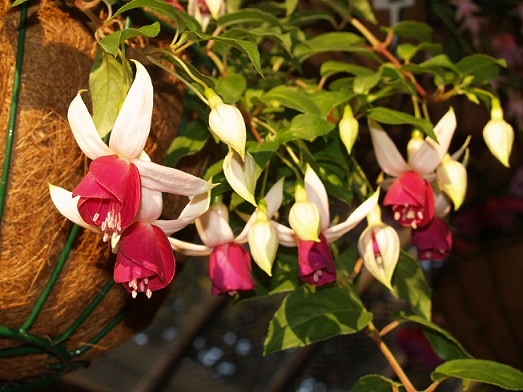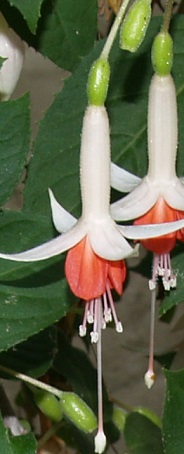Open your eyes to the world of fuchsias!
Fuchsias are one of the
most popular plants grown thanks to their striking and unmistakable
nodding, and often bi-coloured flowers.
There are approximately 100 species, mostly from temperate areas,
and more than 15,000 hybrids and varieties. They vary from small trees
to shrubs and cascading ground covering plants.
Learn everything you ever wanted to know about fuchsias, from soil
management and feeding to pruning and propagation. Discover how fuchsias
are classified into several major groups, the characteristics of those
groups and how/where to grow different types to achieve the best
results.

Course Content
1. Introduction
- Nature and scope of Fuchsias
- Plant Naming
- Plant Families, hybrids, varieties, cultivars
- Classification of Fuchsias (Bushes, Shrubs, Standards, Rockery Plants, Espaliers)
- Dividing the genus Fuchsia into seven sub sections
- Describing Fuchsias (Flowers, Foliage, Floral tubes)
- Resources
2. Culture
- Preparing a garden
- Understanding soils
- Plant nutrition
- Planting, staking, mulching, watering
- Pruning
- Pest and disease, etc.
3. Propagation
- Scope and nature of Fuchsia propagation
- Propagating mixes
- Potting media
- Fuchsias from cuttings
- Stock plants
- Softwood cuttings
- Hormone treatment
- Semi hardwood cuttings
- Disinfecting cutting material
- Best cutting environment
- Managing pest and disease during propagating Fuchsias
4. The Most Commonly Grown Varieties.
There are over 8,000 Fuchsia cultivars, mostly either derived from F. magellanica and F. fulgens; or derived from F. triphylla or related species. This lesson concentrates on these two groups.
- Hardy Fuchsias
- Upright Fuchsias
- Tall Fuchsias
- Medium growers
- Dwarf Growers
- Trailing Fuchsias
5. Other Important Groups.
- Section 1 Quelusia Fuchsias
- Section 2 Eufuchsia
- Section 2a Ellobium
- Section 3 Kierschlegeria
- Section 4 Skinnera
- Section 5 Hemsleyella
- Section 6. Schufia
- Section 7 Encliandra
- How to train a standard Fuchsia
- Espalier Fuchsias
6. The Lesser Grown Varieties
- Less common characteristics
- Less commonly cultivated species
7. Using Fuchsias
- Using colour properly in a garden
- Container growing
- Topiary
- Hanging Baskets
8. Special Assignment
Problem Based Learning project with the following aims:
-
Identify common fuchsias that are grown commercially and sold in and suited to your region.
-
Identify a range of ‘species’ fuchsias suited to your locality.
-
Identify the cultural requirements of fuchsias suited to your locality
-
Outline methods for producing ‘exhibition quality’ fuchsias.
Course Duration - 100 hours of self paced study
If Fuchsias are your Passion, this Course Could be for You
 There are varieties of ferns to be found in all corners of the world, from the Arctic to the tropics, and on every continent except Antarctica. Even though we think of ferns as growing in wet places, this is not always so. Some species in fact thrive in dry climates. There are ferns which grow in coastal areas, exposed to severe wind and salt spray. There are varieties which are drought resistant and others which tolerate extremes of heat or cold.
There are varieties of ferns to be found in all corners of the world, from the Arctic to the tropics, and on every continent except Antarctica. Even though we think of ferns as growing in wet places, this is not always so. Some species in fact thrive in dry climates. There are ferns which grow in coastal areas, exposed to severe wind and salt spray. There are varieties which are drought resistant and others which tolerate extremes of heat or cold.
Generally, those varieties which occur in harsher environments have developed special mechanisms for dealing with extreme conditions. Some are deciduous plants which die back to the roots when the weather becomes severe, then regrow when the season turns more favourable. Other ferns have small, thick, hardy fronds to help them resist cold or wind. Drought-resistant ferns frequently have a covering of scales or hairs which reduce the rate of water loss from the fronds. Many ferns survive dry conditions by growing their roots among and under rocks or logs where the soil remains cool and moist even on the hottest days.
The ideal temperature range for most fuchsias is 18 to 240C. Many varieties stop putting on new growth when temperatures exceed 240C. All gardens have a cool spot, such as under steps, a shaded wall or courtyard, or beneath taller trees, and these are the places you should consider growing fuchsias.
They prefer a well-drained, loose soil high in organic matter. If you have clay or sand, it is necessary to fork through large quantities of compost or well-rotted animal manures before planting.
Once established, fuchsias need regular, heavy feeding to perform well. Young or heavily pruned plants can be fed a high nitrogen fertiliser but once established, use a balanced fertiliser with good levels of phosphorus and potassium as well as nitrogen. An excellent fertiliser for established plants is one of the slow release pellet types applied every three to four months.
Magnesium deficiency can cause yellow streaks or spots on older leaves when a fuchsia has been grown in the same soil for many years. This is easily corrected by sprinkling a couple of pinches of Epsom salts around the base of the plant. Remember that a plant that grows quickly and flowers profusely requires nutrients capable of sustaining this growth.
Always water your fuchsia plants in the morning, if possible. Watering at night can result in the spread of fungal diseases such as ‘damping off’ and cause the dropping of flower buds. Avoid the temptation to overwater if fuchsias wilt a little on a hot day. The soil may still be wet enough, but the foliage is simply not able to take up water fast enough. If the soil gets too wet and soggy “root rots” can develop.
However, do water frequently during dry spells. Place hanging baskets on the ground, or floor of the shade house, in very hot weather. Foliage can be sprayed with a fine mist of water to prevent wilting and to cool the leaves. This will prevent plant stress on a hot day.